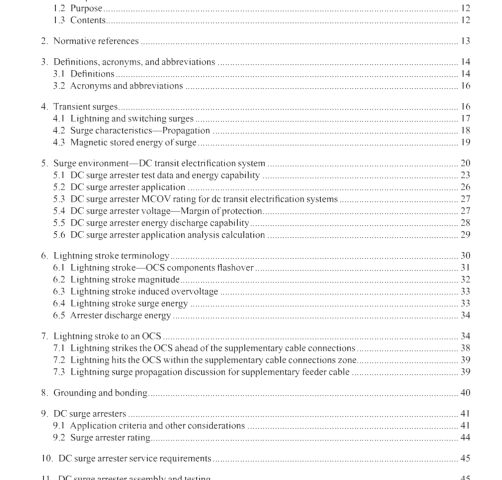IEEE 1627-2019 pdf download.IEEE Standard for Transient Overvoltage Protection of DC Electrification Systems by Application of DC Surge Arresters
3. Definitions, acronyms, and abbreviations
3.1 Definitions
For the purposes ot this document, the following terms and definitions apply. The IEEE Standards Dictionary’
Online should be consulted for terms not defined in this clause.” For additional definitions for understanding dc surge arresters’ various parameters; which are de rms voltages and peak voltages refer to standards.
CENELEC CLCTS 50544, BS EN 50163, EN 50526- 1:2012, EN 50526-2: 2014, EN 50526-3: 2016, and IEC 61992-1:2006.
basic lightning impulse insulation level: Insulation levels designed to withstand surge voltages rather than only normal operating voltages. Since the insulation lines and equipment are protected by surge arresters draining the surges rapidly before the insulation is damaged, the arrester must operate below the minimum basic lightning impulse insulation level (BIL) and must withstand the surges.
clearance: The shortest distance in air between two conductive materials.
creepage distance: The shortest distance along the surface of the insulating material between two conductive materials.
electrical section: The part of an electrical circuit having its own voltage rating for insulation coordination.
fHlashover: Disruptive discharge over a solid surface.
grounded: An electrical section intentionally connected to earth that cannot be interrupted.
impulse: A unidirectional wave of voltage or current that without appreciable oscillations rises rapidly to a maximum value and falls- usually less rapidly– to zero with small. if any, excursions of opposite polarity.
insulated: All components isolated from the energized de conductors by at least one level of insulation. An insulated section shall be under the influence of adjacent energized circuits. An insulated section shall be considered as an electrical section.
keraunic level: The number of thunderstorm days per year in an area.
lightning arrester: See: surge arrester.
lightning flash: A very bright light stream seen in the sky from cloud to ground, or from cloud to cloud, or from ground to cloud on a stormy day.
lightning intensity: The number of lightning strikes /per square meter/year in an area.
lightning strike: Acloud-to-ground lightning strike which is a short-duration stroke that (often but not always)
appears as a single very bright flash and oftien has considerable branching. Syn: lightning stroke.
lightning stroke: See: lightning strike.
nnniinal voltage’ The value assigned to a circuit or system approximately equivalent to the operating voltage for designating the voltage class.
non-linear metal-oxide varistor(1OV): The part otthe surge arresterwhich, by its non-linear voltage verses current characteristic, acts as a low resistance to overvoltage, thus limiting the voltage across the arrester terminals, and as a high resistance at nominal dc voltage or power-frequency voltage.
overhead contact system (0(S): The part ot’craction power electriticauon system comprising of’ overhead conductor(s), aerial feeders, support structure, balance weights and other associated equipment and assemblies, which makes a conducting path through contact wire for the dc power supply to the vehicles Examples include:
a) Single LvnIucl itiv a contact wire electrically connected to a TPSSs by undergroundoverhead teeders. The Contact wire makes contact with the vehicle current collector and is acting as a positive polarity contact point for the dc power supply delivered to the vehicles from (he TPSS.
h) Olwud c’vnducjor rail, various shapes of rigid bars, used in maintenance shops. movable bridges, under bridges, and in tunnels as an alternative to a contact wire or trolley wire
C) Ekciri t,vllcv bus. An electrically powered bus running on rubber-tires drawing dc power by means ot’ trolley overhead positive and negative conductors,
overvoltage: Voltage having a peak value exceeding the maximum steady-state rated voltage during system operating conditions
rated impulse voltage Value of voltage assigned to the equipment ret’ernng ta the specified withstand capability otthe insulation against transient over voltages. This is also called basic impulse level (FIlL), where equipment is tested by using a I .2.50 s lighting impulse voltage wave to assign a RI!. level to equipment
rated insulation voltage The mis withstand voltage assigned to the equipment retrring to the specified permanent (over live minutes) withstand capability of he insulation between energized components and earth
rated voltage The value ot’voltage assigned to a component. device or equipment.
residual discharge voltage (V1j: The peak value ot’voltage that appears between the terminals of an arrester during the passage ot’discharge current
supplementary cable A cable connected in parallel with an OCS is called positive supplementary cable Cable connected an parallel with running rail is called negative supplementary cable.
surge arrester A device intended to limit transient overvoltage to a specified level, It contains nonlinear metal-oxide (MO) elements.
surge-protective device (SPI)) device that is intended to limit transient oversoltage and divert surge currents. It contains at least one nonlinear component.
tempora overs’oltage(F The maximum rms temporary overvoltage value in dc volts that may occur at the dc transit system by vehicle regeneration or Litilitv power supply voltage regulation.
third rail: A conductor of steel. steel aluminum, or other material mounted adjacent to the track rail assembly at the level ot’the track that is electncally connected to the TPSS by underground teders. The third rail makes contact with vehicle current collector and acts as a positive polarity point for the dc power supply delivered to the vehicles trom the TPSS.IEEE 1627 pdf download.IEEE 1627-2019 pdf download
IEEE 1627-2019 pdf download

Leave a Reply